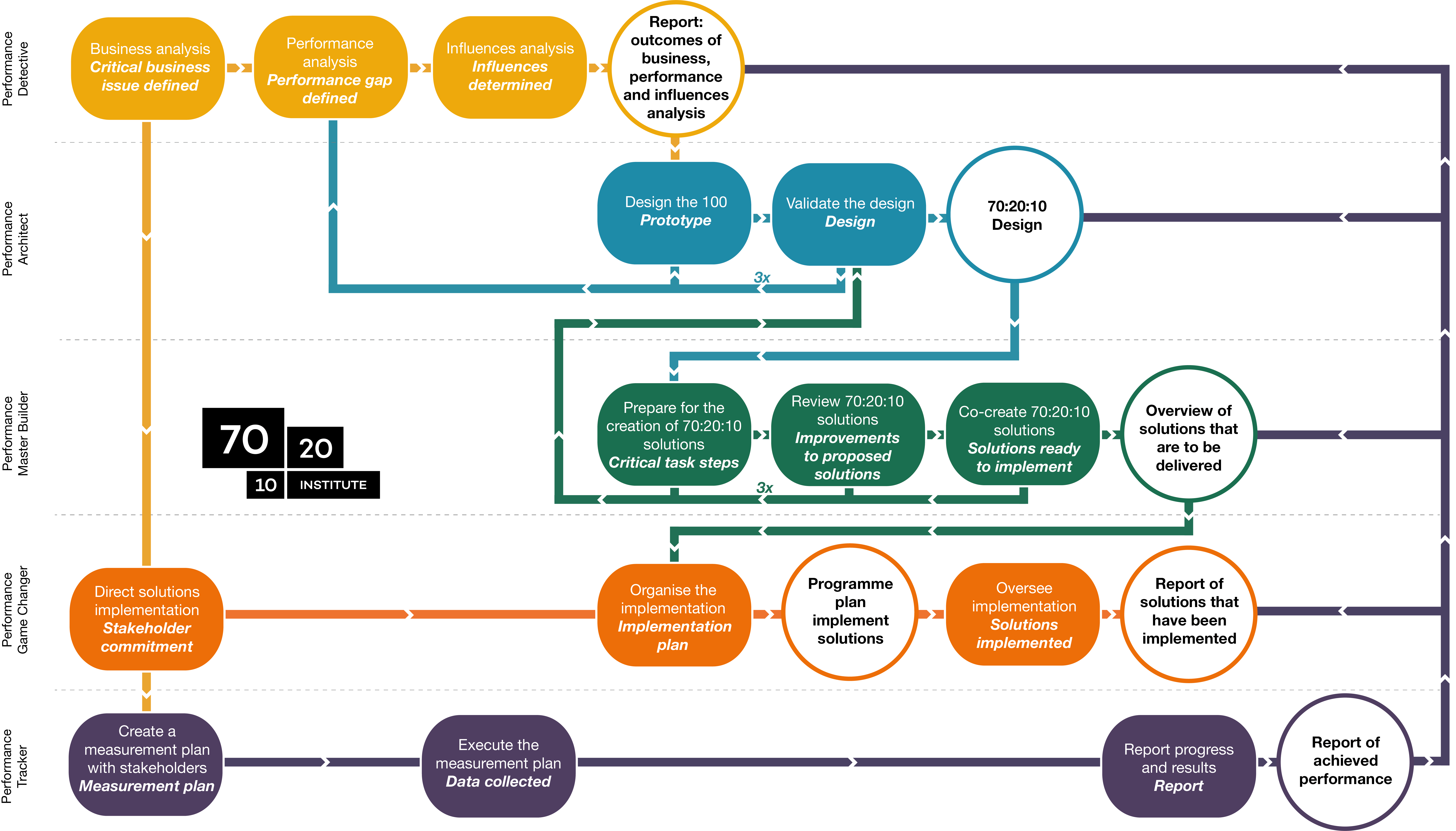New roles and services for HRD with 70:20:10
There is a great deal of interest in 70:20:10 but it is not an easy task to base organisational learning on this methodology. We have therefore introduced five new roles for HRD (Human Resource Development) professionals seeking to implement the model. In this way HRD can expand the service it provides by supporting not only formal learning, the 10, but also new ways of learning by working together, the 70 and 20.
Why does HRD need new roles?
70:20:10 shifts its service provision from formal learning (the 10) to learning by working (the 70) and learning from and through others (20). This may appear to be a minor difference but it has major implications for the service.
The current provision is concentrated on formal learning and consists of a variety of courses, workshops, coaching, eLearning and other tools. Many of these formal solutions are not integrated with work: the knowledge they provide does not correspond sufficiently with that which people need to work more effectively.
70 and 20 services, on the other hand, mainly provide knowledge, information and communication that helps employees to work better. Clearly, formal learning is an integral part of these services, but as the focus of the provision shifts, new forms of HRD service develop and become important to the organisation’s core activities. By supporting management and staff in improving their workplace performance, HRD becomes less a supplier of formal learning solutions and more a value-added business partner.
As suppliers of formal solutions, HRD professionals organise their work processes, roles and critical tasks in a recognisable manner. These include processes that disseminate formal learning as effectively as possible in learning-focused organisations and playing a key part as training designers.
If HRD acts as a business partner and contributes to the organisation’s desired results the focus shifts from learning to performing, and to learning from performance. This includes new roles and tasks within the process that help HRD professionals to work in collaboration with the business.
Five new roles that help HRD to implement a 70:20:10 service
These roles create a tangible connection to the organisation’s core activities with the primary focus on combining work and learning. They enable HRD to expand its service to include the 70 and 20 and ensure that the solutions provided by 70:20:10 are mutually reinforcing.

The Performance Detective
The Performance Detective reports on critical problems within the organisation, quantifies the performance deficit and its underlying causes, identifies the functions involved and provides an overview of critical tasks. This requires an analysis of the business and its performance, and the causes of any performance problem or source of improvement opportunity. It goes further than the current role of HRD in which training needs are the focus of the analysis.

The Performance Architect
The Performance Architect delivers a prototype design for the 100, the performance objectives and the high-level (i.e. non-detailed) implementation of the 70:20:10 solutions. He or she first designs the 100, and then the 70, 20 and 10. This is a significantly different role to that of the training designer, who provides formal solutions, the 10.

The Performance Master Builder
Unlike a training designer, the Performance Master Builder constructs specific 70, 20 and 10 solutions, in that order. As a result the HRD service expands significantly into the 70 and 20, and fewer 10 solutions are likely to be needed.

The Performance Game Changer
The Performance Game Changer implements the 70:20:10 solutions in order to contribute to the desired performance improvement. This is a new role for HRD because in formal learning solutions (the 10) development and implementation are theoretically one and the same. In other words, as a provider of 10 solutions, HRD stops offering and implementing formal learning solutions at the 10 because its responsibilities end here. The Game Changer, on the other hand, implements the full spectrum of 70:20:10 solutions and thus acts as a change manager. The Game Changer also has a role in connecting 70:20:10 solutions to the organisation. This involves communication activities.

The Performance Tracker
One of the Performance Tracker’s critical tasks is to measure the progress of the desired performance improvements on an ongoing basis. The target outcome is that timely monitoring and management of progress make it possible to close the performance gap and deliver a clear and positive business case.
The connection between the five new roles
These roles can be viewed in isolation, but cannot be physically separated. The Detective, Tracker and Game Changer work together from the outset, as do the Architect, Master Builder and Game Changer. The roles, and the relevant critical tasks, are used to develop a new HRD methodology that is dynamic and cyclical rather than linear, as shown by the swimming-pool lines in fig. 1.

New roles for HRD teams
Some HRD professionals will question the new roles and the idea of working as a team. Others will quickly identify with one or more of the roles which form the foundation of the methodology and perform a new and more business-oriented function. This makes their self-identification very different from the perception of their current roles and tasks. However, it is important not to confuse self-identification with one or more roles of the 70:20:10 methodology. Identification simply means being effective in a new way of thinking with a completely different perspective on working and learning than that provided by regular training studies. It is therefore important to start by gaining sufficient insight and capacity (obviously using 70:20:10), before you become, for example, a self-appointed Performance Architect.
The new roles are suited to be carried out in teams, especially in larger HRD departments where people already work in groups. They can be used to create a division of labour and in our experience team members will naturally gravitate towards their preferred roles.
It is difficult, but not impossible, for one person to carry out all five roles due to the scope of critical tasks and desired outcomes specified for each role.
New roles aren’t just for HRD
The design of the new roles seeks to achieve an effective connection between HRD and the core of the organisation and thus to create completely new ways of consolidating the relationship. For example the roles of Performance Detective and Performance Tracker are ideally suited to managers or to colleagues from other parts of the organisation such as those in organisational development, lean management, and risk management. HR business partners can also carry out one or more of the roles quite successfully.
Multidisciplinary co-operation is recommended because it creates a greater sense of involvement and provides knowledge that can be used to implement any 70:20:10 project successfully. Clearly the different roles cannot be taken over by other professionals in isolation without adequate 70:20:10 knowledge and skills. It is essential that everyone has a thorough knowledge of the methodology and new roles, which of course are acquired using 70:20:10.







